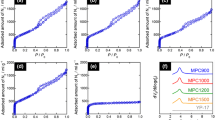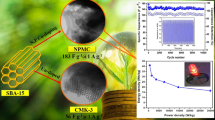Abstract
A series of ordered mesoporous carbons (OMCs) have been synthesized by filling the pores of siliceous SBA-15 hard template with various carbon precursors including sucrose, furfuryl alcohol, naphthalene and anthracene, followed by carbonization and silica dissolution. The carbon replicas have been characterized by powder XRD, TEM and N2 adsorption techniques. Their electrochemical performance used as electric double-layer capacitors (EDLCs) were also conducted with cyclic voltammetry and charge-discharge cycling tests. The results show that highly ordered 2D hexagonal mesostructures were replicated by using all these four carbon sources under the optimal operation conditions. Physical properties such as mesoscopic ordering, surface areas, pore volumes, graphitic degrees, and functional groups are related to the precursors, but pore sizes are shown minor relationship with them. The sources, which display high yields to carbons, for example, furfuryl alcohol and anthracene are favorable to construct highly ordered mesostructures even at high temperatures (1300 °C). OMCs prepared from non-graphitizable sources such as sucrose and furfuryl alcohol display amorphous pore walls, and large surface areas and pore volumes. The functional groups in the precursors like sucrose and furfuryl alcohol can be preserved on carbon surfaces after the carbonization at low temperatures but would be removed at high temperatures. The graphitizable precursors with nearly parallel blocks and weak cross-linkage between them like anthracene are suitable for deriving the OMCs with graphitic walls. Therefore, the OMCs originated from sucrose and furfuryl alcohol behave the highest capacitances at a carbonization of 700 °C among the four carbons due to the high surface areas and plenty of functional groups, and a declination at high temperatures possibly attribute to the depletion of functional groups. Anthracene derived OMCs has the lowest capacitance carbonized at 700 °C, and a steady enhancement when heated at high temperatures, which is attributed to the graphitization. The OMCs derived from naphthalene have the stable properties such as relatively high surface areas, few electroactive groups and limited graphitizable properties, and in turn medium but almost constant capacitances.
Similar content being viewed by others
References
R. Ryoo, S.H. Joo, S. Jun, J. Phys. Chem. B. 103, 7743 (1999)
R. Ryoo, S.H. Joo, M. Kruk, M. Jaroniec, Adv. Mater. 13, 677 (2001)
S. Jun, S.H. Joo, R. Ryoo, M. Kruk, M. Jaroniec, Z. Liu, T. Ohsuna, O. Terasaki, J. Am. Chem. Soc. 122, 10712 (2000)
M. Kaneda, T. Tsubakiyama, A. Carlsson, Y. Sakamoto, T. Ohsuna, O. Terasaki, S.H. Joo, R. Ryoo, J. Phys. Chem. B. 106, 1256 (2002)
S.H. Joo, S.J. Choi, I. Oh, J. Kwak, Z. Liu, O. Terasaki, R. Ryoo, Nature 412, 169 (2001)
J. Lee, S. Yoon, T. Hyeon, S.M. Oh, K.B. Kim, Chem. Commun. 2177, (1999)
J.S. Lee, S.H. Joo, R. Ryoo, J. Am. Chem. Soc. 124, 1156 (2002)
H.F. Yang, Q.H. Shi, X.Y. Liu, S.H. Xie, D.C. Jiang, F.Q. Zhang, C.Z. Yu, B. Tu, D.Y. Zhao, Chem. Comm. 2842, (2002)
J. Lee, K. Sohn, T. Hyeon, J. Am. Chem. Soc. 123, 5146 (2001)
H.F. Yang, Y. Yan, Y. Liu, F.Q. Zhang, R.Y. Zhang, Y. Meng, M. Li, S.H. Xie, B. Tu, D.Y. Zhao, J. Phys. Chem. B. 108, 17320 (2004)
A.B. Fuertes, S. Alvarez, Carbon. 42, 3049 (2004)
T.W. Kim, I.S. Park, R. Ryoo, Angew. Chem. Int. Ed. 42, 4375 (2003)
Y.D. Xia, Z.X. Yang, R. Mokaya, J. Phys. Chem. B. 108, 19293 (2004)
K. Bohme, W.D. Einicke, O. Klepel, Carbon. 43, 1918 (2005)
M. Kruk, M. Jaroniec, T.W. Kim, R. Ryoo, Chem. Mater. 15, 2815 (2003)
A.H. Lu, W. Schmidt, B. Spliethoff, F. Schuth, Adv. Mater. 15, 1602 (2003)
D.Y. Zhao, J.L. Feng, Q.S. Huo, N. Melosh, G.H. Fredrickson, B.F. Chmelka, G.D. Stucky, Science. 279, 548 (1998)
A.H. Lu, W.C. Li, W. Schmidt, W. Kiefer, F. Schuth, Carbon. 42, 2939 (2004)
C.H. Kim, D.K. Lee, T.J. Pinnavaia, Langmuir 20, 5157 (2004)
Y.S. Lim, H.S. Kim, M.S. Kim, N.H. Cho, S. Nahm, Macromole. Res. 11, 122 (2003)
D.J. Kim, H.I. Lee, J.E. Yie, S.J. Kim, J.M. Kim, Carbon. 43, 1868 (2005)
E.B. Sanders, A.I. Goldsmith, J.I. Seeman, J. Anal. & Appl. Pyroly. 66, 29 (2003)
S.M. Manocha, D.Y. Vashistha, L.M. Manocha, J. Mater. Sci. Lett. 16, 705 (1997)
A. Shindo, K. Izumino, Carbon 32, 1233 (1994)
K.P. Gierszal, T.W. Kim, R. Ryoo, M. Jaroniec, J. Phys. Chem. B. 109, 23263 (2005)
T.W. Kim, Ryoo, R.K. P. Gierszal, M. Jaroniec, L.A. Solovyov, Y. Sakamoto, O. Terasaki, J. Mater. Chem. 15, 1560 (2005)
Y. Sakamoto, T.W. Kim, R. Ryoo, O. Terasaki, Angew. Chem. Int. Ed. 43, 5231 (2004)
F. Schuth, Angew. Chem. Int. Ed. 42, 3604 (2003)
V.A. Davydov, A.V. Rakhmanina, V. Agafonov, B. Narymbetov, J.P. Boudou, H. Szwarc, Carbon. 42, 261 (2004)
I. Mochida, Y. Korai, C.H. Ku, F. Watanabe, Y. Sakai, Carbon. 38, 305 (2000)
A. Burian, P. Daniel, S. Duber, J. Dore, Philosophical Magazine B. 81, 525 (2001)
P.J.F. Harris, Int. Mater. Rev. 42, 206 (1997)
S. Ergun, V.H. Tiensuu, Acta Crystallogr. 12, 1050 (1959)
S. Ergun, L.E. Alexander, Nature 195, 765 (1962)
A. Oberlin, Carbon 22, 521 (1984)
J.N. Rouzaud, A. Oberlin, Carbon 27, 517 (1989)
E. Frackowiak, F. Beguin, Carbon 39, 937 (2001)
M. Winter, R.J. Brodd, Chem. Rev. 104, 4245 (2004)
A.S. Arico, P. Bruce, B. Scrosati, J.M. Tarascon, W. Van Schalkwijk, Nature Mater. 4, 366 (2005)
H.Y. Liu, K.P. Wang, H.S. Teng, Carbon 43, 559 (2005)
A.B. Fuertes, F. Pico, J.M. Rojo, J. Power Sources 133, 329 (2004)
S. Yoon, J.W. Lee, T. Hyeon, S.M. Oh, J. Electrochem. Soc. 147, 2507 (2000)
K.L. Yang, S. Yiacoumi, C. Tsouris, J. Electroanal. Chem. 540, 159 (2003)
Acknowledgment
This work was supported by NSF of China (20407014, 20421303, 20373013 and 20521140450); State Key Basic Research Program of PRC (2006CB202502); Shanghai Sci. & Tech. Committee (06DJ14006, 055207078, 05DZ22313, and 03QF14037); Shanghai Nanotech Promotion Center (0652nm024), Shanghai Education Committee (02SG01, 04DB05 and T0402); Program for New Century Excellent Talents in University (NCET-04-03). We thank Dr. S. H. Xie for TEM assistance. Y. W. thanks the China Post-Doc Scientific Fund.
Author information
Authors and Affiliations
Corresponding author
Rights and permissions
About this article
Cite this article
Zhai, Y., Wan, Y., Cheng, Y. et al. The influence of carbon source on the wall structure of ordered mesoporous carbons. J Porous Mater 15, 601–611 (2008). https://doi.org/10.1007/s10934-007-9139-x
Received:
Accepted:
Published:
Issue Date:
DOI: https://doi.org/10.1007/s10934-007-9139-x




